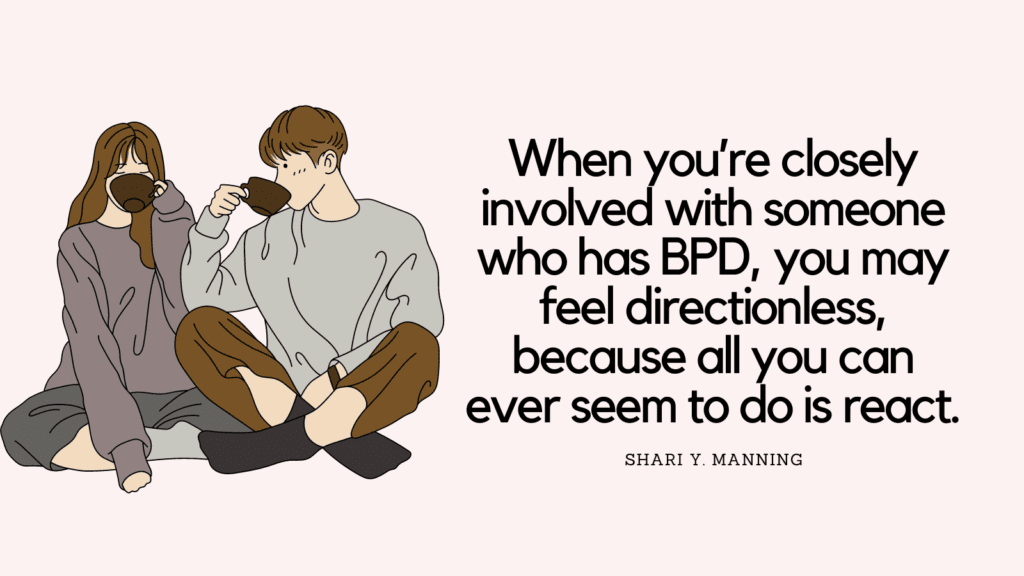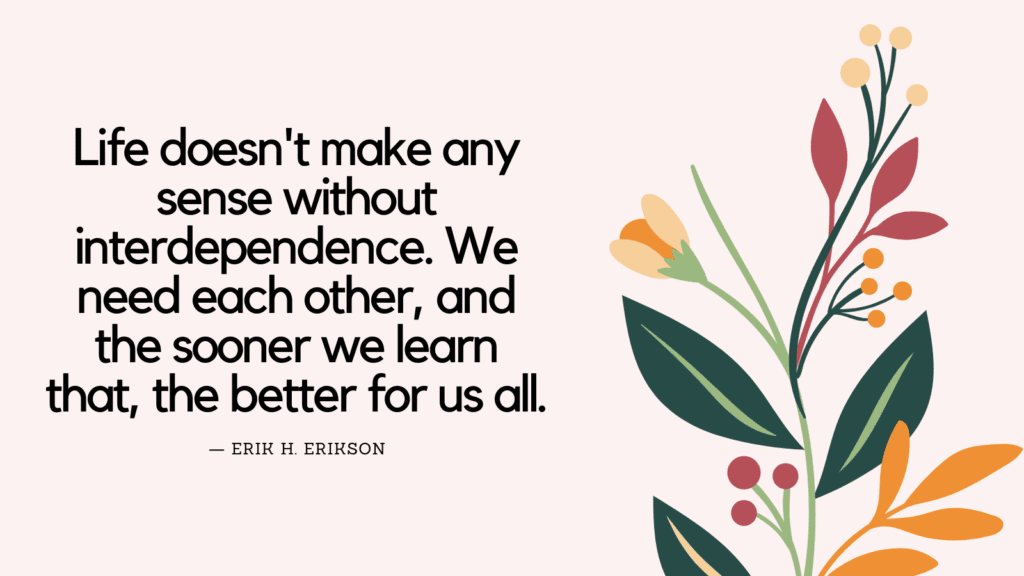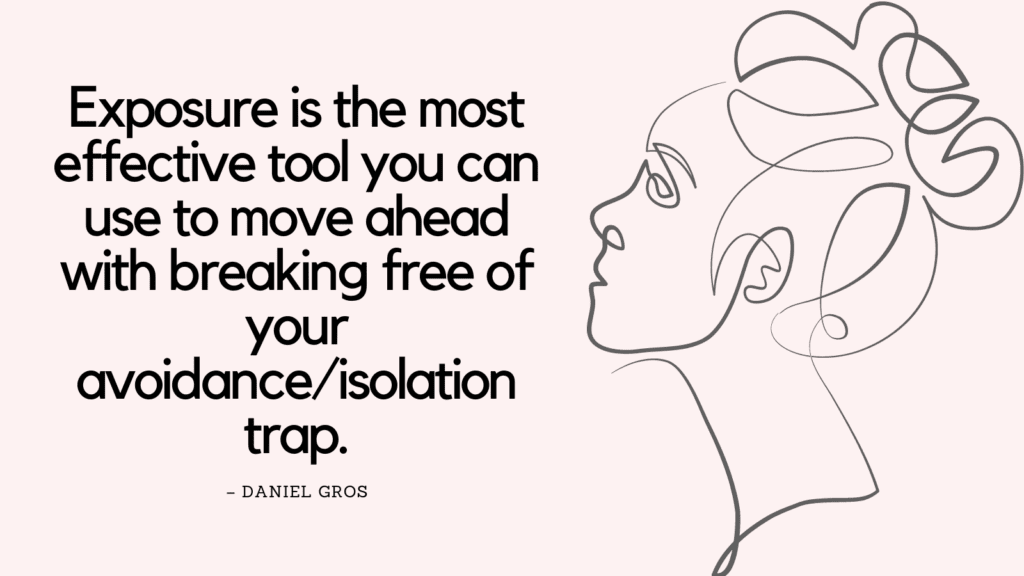This post contains some of the best loving someone with BPD quotes.
What Is BPD?
BPD stands for Borderline Personality Disorder.
It is a mental health disorder characterized by unstable moods, behaviors, and relationships.
The DSM-5 (Diagnostic and Statistical Manual of Mental Disorders, 5th Edition) is a widely used manual for diagnosing psychiatric disorders and provides the criteria used to diagnose BPD.
According to the DSM-5, the diagnostic criteria for Borderline Personality Disorder include:
1. Frantic efforts to avoid abandonment, whether real or perceived.
2. Patterns of unstable and intense interpersonal relationships, characterized by alternating between extremes of idealization and devaluation.
3. Identity disturbance, such as unstable self-image or sense of self.
4. Impulsive behaviors that are potentially self-damaging (e.g., spending sprees, substance abuse, reckless driving, unsafe sex).
5. Recurrent suicidal behaviors, gestures, threats or self-harming behaviors.
6. Emotional instability due to marked reactivity of mood, with frequent and intense episodes of sadness, irritability, or anxiety usually lasting a few hours, but rarely more than a few days.
7. Chronic feelings of emptiness.
8. Difficulty controlling anger, resulting in frequent displays of temper, and sometimes physical fights.
9. Transient, stress-related paranoid ideation or severe dissociative symptoms.
To receive a diagnosis of BPD, an individual should exhibit at least five of these symptoms, including a pattern of unstable relationships and disturbances in self-identity, as well as pervasive emotional dysregulation.
It’s important to note that only qualified mental health professionals can provide a formal diagnosis after a thorough evaluation.
Loving Someone With BPD Quotes
1. ““How could she do that to me—and herself—over and over?” “Why would anyone act like that?” “I don’t know how much more I can take. But I’ve left before, and I keep coming back. What’s wrong with me?” “How can I possibly help him when I have no idea where to start?” If you love someone with borderline personality disorder (BPD), you’ve probably asked all of these questions at some point or other, maybe repeatedly” – Shari Y. Manning
2. ““What were you thinking?” is something you may have asked your loved one time and time again. Baffling behavior, emotional reactions, interpersonal gaffes, and a lot of doubt about who they are can leave onlookers flabbergasted by the way people with BPD lead their lives. The answer to your question is that your loved one may very well not be thinking exactly the same way you do.” – Shari Y. Manning
3. “…person with BPD has emotions that are like tornadoes. They can appear out of nowhere, gather strength, and wreak destruction. The emotional states of people with BPD change rapidly, and it’s hard for the rest of us to keep up with them. It’s emotion that’s at the heart of the chaos. Because people with BPD often have no control over their emotions, they also seem to have very little control over their behavior” – Shari Y. Manning
Related: Top 7 Skills For Coping With BPD [+ BPD FREE Resources]
4. “As to personality disorder, what you need to know about this term is that it means your loved one exhibits a chronic pattern of behaviors that are based in his or her personality, which means essentially that they affect everything: moods, actions, and relationships. You can probably see this pretty plainly for yourself.” – Shari Y. Manning
5. “As you probably know from experience, it’s the unpredictability that you can count on with emotional lability—when someone has extreme emotional reactions that are quick to change, you never know what exact reaction you’re going to get.” – Shari Y. Manning
6. “Because the person with BPD has such extreme emotional pain, she can at times take that pain out on you. Like the “person on fire” example, YOU can get burned if she runs up to you and transmits the fire to you. YOU can be hurt as she bowls you over on the way to the lake that she believes will quench her fire. It hurts, regardless of whether you’re bowled over…or burned.” – Bon Dobbs
7. “Family members and loved ones often find themselves trying to rescue people with BPD.” – Shari Y. Manning
8. “Have you ever had a time when your loved one was really upset about something (or at you) and you had absolutely no idea what the upset was about?” – Shari Y. Manning
Related: Borderline Personality Disorder Support Group
9. “If you’ve ever been with someone with BPD, thinking everything was going fine, only to get a phone call 2 hours later and hear that the person is very distressed and how upset she is by what you did, you have witnessed emotional sensitivity.” – Shari Y. Manning
10. “If your loved one quits jobs or relationships, binges, purges, drinks, takes drugs, shoplifts, commits crimes, runs away, or does anything that is impulsive, he is engaging in dysregulated behavior. What drives these behaviors is that they very often serve to make the person feel better or at least to eliminate intense emotion.” – Shari Y. Manning
11. “It is important that you understand what is going on with your loved one. Only by understanding what is going on can you learn how you can do anything about it.” – Bon Dobbs
Healthy Relationship Checklist
12. “It may be that your loved one has never exhibited shame to you. If she has not revealed this sense of shame, she is behaving in a completely natural manner. It is not a matter of trusting you or not trusting you. The natural reaction to shame is to hide. Letting another person know that you carry around a feeling of shame involves much vulnerability.” – Bon Dobbs
13. “Loving someone who injures him/herself is an exercise in knowing your limitations. No matter how much you care about someone, you cannot force them to behave as you’d prefer them to.” – Bon Dobbs
14. “Many people find themselves compelled to find out the “whys” of BPD and to understand what caused the disorder in their loved one. Searching for a “why” can be disheartening, because the causes of the disorder can often not be attributed to a single factor, either biological or environmental.” – Bon Dobbs
Related: Saying No To Someone With Borderline Personality Disorder
15. “Maybe you’re familiar with this scenario: You’re in a room with your loved one who has BPD. You’re having a great time, and it seems pretty clear that your loved one is too. there’s a lot of laughter and sharing and mutual understanding. Your loved one—let’s say it’s your brother—goes home, and you’re left with the glow of good will. Then all of a sudden, hours later, you get a phone call. It’s your brother, and he’s spewing out a list of all the things that you said and did that hurt him terribly. You’re completely thrown. Were you two even in the same room together? Did you imagine the whole encounter? Were you that blind to the fact that your brother was upset at the time? No wonder you feel lost.” – Shari Y. Manning
16. “Maybe your loved one is dramatic, impulsive, and emotional, the profile that’s pretty common and that I’ve been alluding to so far in this chapter. But your loved one could also qualify for the disorder if she often seems emotionless or numb.” – Shari Y. Manning
17. “Now you’re constantly worried that your brother may kill himself the next time you upset him. And you start to feel a lot of resentment. You stay in the relationship, feeling like a yo-yo, bouncing back and forth between despair that your relationship is out of control and hope that things can be better.” – Shari Y. Manning
18. “One of the things that you will need to accept about your loved one is that she has a serious mental illness and that she may never be completely normal. It is perfectly natural to grieve for the “normal” child or “normal” relationship that you may never attain – so go ahead cry and mourn if you feel sad. After the grieving, acceptance should make it easier. This is not to say there is no hope – little-by-little things can get better, but the choice to make things better is sometimes not completely yours.” – Bon Dobbs
Related: Best 20 Tips On Dating Someone With BPD Without Becoming A Caretaker
19. “That instinct is even stronger when we see the person we love experiencing emotional agony. You’ve probably made herculean efforts to try to “fix” whatever is hurting your loved one. Why, then, do all your efforts seem to fail—or make things worse?” – Shari Y. Manning
20. “The fact is that there are so many reasons we love people with BPD. Most are kind and generous of spirit” – Shari Y. Manning
21. “Unfortunately, when you’re observing—and being affected by—impulsive behaviors that cause your loved one such trouble, you can end up feeling helpless and lost in chaos. You want to understand and help, and yet your spouse or sibling just keeps shooting him- or herself in the foot.” – Shari Y. Manning
22. “When someone acts so caring, you can easily question whether your anger at the aggressive, frightening behavior that you see at other times is justifiable.” – Shari Y. Manning
23. “When you’re closely involved with someone who has BPD, you may feel directionless, because all you can ever seem to do is react.” – Shari Y. Manning
24. “When you’re trying to understand suicidal behaviors in your loved one, it’s particularly important to avoid the judgmental idea that these actions are intended to manipulate you or someone else.” – Shari Y. Manning
Related: Emotional Permanence (What Is It & Top 4 Tips On How To Cope With Emotional Permanence Deficit?)
25. “Whether your loved one is having positive or negative emotions, the fact that you wouldn’t have an emotional reaction to whatever just set off your loved one’s emotions can make it really hard for you to identify the trigger at all, so you may often feel blindsided.” – Shari Y. Manning
26. “You go from one extreme to the other, from trying to make sure nothing upsets the person you love to trying to get away from the person at all costs. You may feel like you’re caught in a riptide, unsure when the behaviors that upset you are going to stop and where you’re going to be dropped off at the end.” – Shari Y. Manning
27. “You may think that, if the person with BPD is your spouse or child, “who else, other than me, is supposed to solve my loved one’s problems? Isn’t that what being a loved one is all about?” The short answer to those questions is: they have to solve their own emotional problems and no, that is not what being a loved one is all about. Your job as a loved one is to listen and empathize, but not solve.” – Bon Dobbs
28. “If you learn to master validation, you can see a marked change in the way your BP loved one interacts with you.” – Bon Dobbs
29. “Most people believe that remaining calm in the face of strong emotions expressed by their BP loved one is the best and most effective course of action, but in reality, it is not. A study of BPD patients using functional MRI technology “found that the level of amygdala activation to the Fearful, and Neutral faces in BPD patients is significantly correlated with diagnostic measures of emotional lability.”” – Bon Dobbs
30. “I often have people ask me, “What do I do now?” after their loved one is diagnosed with BPD or they realize that their loved one has BPD. My answer is: do what is effective and use these tools to be effective” – Bon Dobbs
Related: Top 10 BPD Books To Help You Cope With Borderline Personality Disorder
31. “When the person with BPD is in fear of being abandoned all bets are off, and they will do almost anything to avoid being left. In addition to frantic attempts to hold onto their loved one, the BPD may also intentionally drive people they care about away. Why you may ask. Simply to beat the person to the punch, and avoid the hurt of being abandoned. The BPD is already convinced that you are leaving. They know it is just a matter of time.” – Ozzie Tinman
32. “I must be defective. That was the only explanation I could think of for his behavior. Why did he act so loving one moment and then rip me to shreds the next? Why did he tell me I was talented and wonderful and then scream at me that I was contemptible and the cause of all his problems? If he loved me as much as he said he did, why did I feel so manipulated and powerless? And how could someone so intelligent and educated sometimes act so completely irrational?” – Paul T. Mason & Randi Kreger
33. “Rather than dwell on the diagnosis per se, help the person see that in any relationship, both people bear responsibility for the way things are. (You may feel that the BP is responsible for all the problems, but set this aside for now.) Your message should be that when there are problems in relationships, both people need to work on them together.” – Paul T. Mason & Randi Kreger
34. “Remember, the other person may or may not have BPD. And even if they do, that may not completely explain their behavior. Switch the focus from wondering about the possible causes of their actions to solving problems that result from those actions and behaviors.” – Paul T. Mason & Randi Kreger
35. “When you’re living with someone with BPD, however, it can be difficult to separate BPD from the person who suffers from it. Borderlines recover.” – Paul T. Mason & Randi Kreger

36. “As you and your loved one separate the false-hood from reality, you can start over together again with a more consistent, trusting relationship.” – Jerold J. Kreisman
37. “Enduring the “I hate you” part of BPD is perhaps the most formidable challenge to maintaining your relationship with your loved one.” – Jerold J. Kreisman
38. “Feelings of emptiness hinder intimacy. And the need for another to fill that emptiness may be all- consuming.” – Jerold J. Kreisman
39. “For the loved ones of individuals with BPD, borderline behavior can be confounding. The BP craves relationships, yet constantly challenges those with whom he is in relationships. His sudden rage may erupt from the smallest provocation, blocking attempts at closeness. The BP’s fear of abandonment battles his fears of engulfment and distrust of closeness.” – Jerold J. Kreisman
40. “If you love someone with borderline personality disorder (BPD), you already know that the relationship can often be strained. You know that your loved one can exhibit changeable moods, impulsive behaviors, and even self- defeating activities that challenge your commitment.” – Jerold J. Kreisman
Related: Yellow Flags In A Relationship
41. “It is important to understand that the BP’s behavior is a symptom of his illness, developed as a mechanism to shield him from hurt. It is not entirely a debasement of you.” – Jerold J. Kreisman
42. “It is truly a profound display of caring commitment to maintain your love for someone struggling with BPD.” – Jerold J. Kreisman
43. “Learning to be with someone with BPD can be a consuming challenge.” – Jerold J. Kreisman
44. “People with BPD often become very involved with potential givers of care or love, even after a cursory meeting, and idealize the other person’s virtues and capacities. If they are disappointed by that person, however, there can be a rapid shift to devaluing the other person, who now does not give or care nearly enough.” – Penny Steiner-Grossman & Patricia Woodward
45. “The constellation of symptoms that we label BPD has profound effects on the person experiencing it, and it may be disturbing and mystifying to you as well.” – Jerold J. Kreisman
46. “The perception of impending separation from an important other person has a destabilizing effect on the mood, sense of self, thought patterns, and behavior of the person with BPD. The person with BPD often misinterprets even the most realistic separations as rejections and indications that he or she is “bad.”” – Penny Steiner-Grossman & Patricia Woodward
47. “Your loved one can fill some of the emptiness that partially defines BPD by developing a dependable sense of who he is, what his values are, and the ability to understand his world, even with its contradictions.” – Jerold J. Kreisman
48. “What it takes to sustain your relationship with someone with BPD is a very personal question. Just as everyone’s tolerance of physical pain is different from one person to the next, so tolerance of how much emotional exertion people can make to maintain the connection varies.” – Jerold J. Kreisman
49. “Recognizing and understanding the various presentations of BPD is a first step in preparing constructive methods of interaction.” – Jerold J. Kreisman
50. “In a healthy relationship you can learn how to love and stay with someone with BPD, without losing yourself.” – Jerold J. Kreisman
Related: Best 10 Books On Emotional Unavailability
References
- Portions of this article were adapted from the book Loving Someone With Borderline Personality Disorder, © 2011 by Shari Y. Manning. All rights reserved.
- Portions of this article were adapted from the book When Hope Is Not Enough, © 2008 by Bon Dobbs. All rights reserved.



